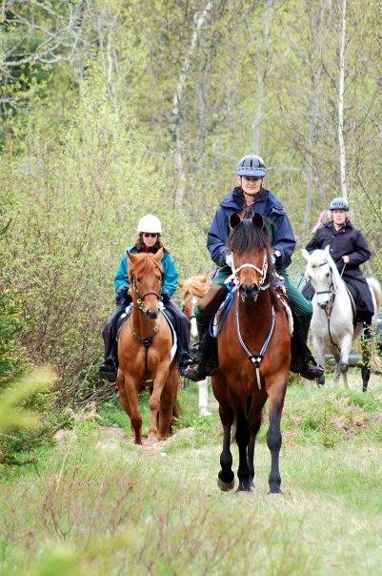Eating Green
Eating Green
High-fat diets may be as unhealthy for horses as they are for human
by Clare Illingworth
Ideal images of horses feeding on verdant pastures are fading from sight in North America's equine industry. Today, many horses spend much of their time confined to stalls, where they receive specialized feeds.
For some, their menus are high in fat, which is believed to be more conducive to performance ability. But putting such distance between genetic heritage and modern practices may not be a healthy practice, researchers say, because stepping away from horses' natural food sources could be affecting the way they store and release muscle energy during exercise. And that's critical for all equine athletes.
Prof. Jill McCutcheon, Pathobiology, has teamed up with Prof. Ray Geor and Ph.D. student Shannon Pratt of the Department of Animal and Poultry Science to determine the differing impacts of high-fat feeds and common starch feeds on glucose regulation in the blood and muscles of young horses. High-fat feeds have become increasingly popular because they maintain weight without making a horse "hot," an industry term for having too much energy.
"There is little information about how diet affects horses," says Geor. "We know they relay on carbohydrates such as glucose for energy during exercise, but we don't know how this supply is regulated or replenished."
Adds McCutcheon: "Glucose regulations affects every aspect of your body, including growth and performance. People feed their horses every day, but we know so little about how nutrients are used at the cellular level."
In athletes, humans and horses alike, glucose provides fuel for the body (surplus is stored in the muscles as glycogen). Glucose, which comes from carbohydrates such as starches in grains, is dispersed though the blood. Insulin, a hormone, senses high levels of this blood sugar and triggers an appropriate glucose absorption by the muscles.
Increasing the amount of fat in a diet allows the starch content to be lowered, so insulin is released less often. But this may ultimately lower insulin sensitivity, meaning it's difficult for the horse to properly digest starches. It's believed this affects insulin, blood glucose and muscle glycogen.
"A high-fat diet is used by humans suffering Type 1 diabetes because their bodies don't create the required amount of insulin," Says Pratt. "Caregivers are feeding the same diet to their horses without really considering the implications."
Physical training may alter this effect. Technology used during human clinical diabetic research will be used to measure the rate insulin removes glucose from the blood. It's anticipated that although fat-supplemented diets may alter the ability to digest starches when horses aren't working, physical training may lessen the impact and thus reduce concerns about the starch content of the diet.
The project began last winter with 12 horses. It's sponsored by the E.P. Taylor Fund, the Equine Research Fund and the Ontario Ministry of Agriculture and Food. Other researchers involved are Prof. John Burton of the Department of Animal and Poultry Science, veterinary student Carleen Foot and pathobiology technician Leach Rae Read.
Fueling the equine athlete
Oats have been a staple in horse feed for decades, added to hay-based diets to boost energy intake. But new research says oats and other such starches may not be the best way to replenish lost energy stores after a strenuous workout. Instead, alternative energy sources could be the answer to fueling the equine athlete to a new level.
Prof. Ray Geor, Department of Animal and Poultry science, is trying to determine which foods best replenish a horse's lost muscle energy."Many sports require great athleticism in the horse," says Geor. "It's important that we fully understand how feeding and nutrition can affect their athletic potential."
Excess starches from the diet are stored in the muscles as glycogen, a complex sugar molecule. During exercise, these glycogen stores are used up, then require a considerable amount of time, sometimes longer than a day, to replenish. Geor believes the feeding regimen shortly after exercise can help speed up this process, allowing horses and trainers to get the most out of daily workouts. Feeding too much starch-based grain can overload the digestive system, sending undigested starches to the large intestine. This can lead to digestive upset that, in horses, could become colic, a potentially deadly condition. Geor is testing whether fats, proteins and various forms of carbohydrates, as well as timing relative to exercise, affect glycogen stores and future athletic performance. "Sequential training days can decrease the horse's glycogen stores," he says. "By looking at different energy types, we hope to identify feeding strategies that best enhance athletic potential and post-exercise recovery."
This research is sponsored by Purina Mills LLC.
From Volume XVIII, Number 1
Research, University of Guelph, Spring 2003

- Log in to post comments
